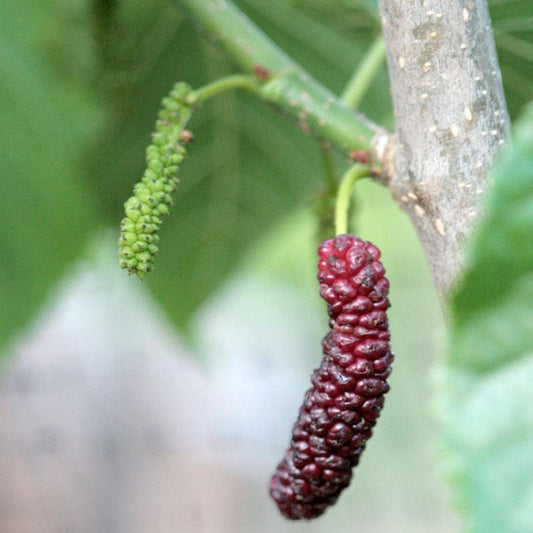Mulberry trees, belonging to the family Moraceae, are renowned for their delicious fruits and ornamental value. These deciduous trees, particularly the Morus alba species, encompass a diverse range of varieties, including native red mulberries (Morus rubra) and the widely cultivated black mulberry (Morus nigra). Across the United States, mulberry plants are appreciated for their fast growth, resilience, and ability to thrive in various climates.
Reaching up to 40 feet tall, female trees produce an abundance of fruit, which varies in color depending on the species—ranging from white fruit in some cultivars of Morus alba to dark purple berries in black mulberries. Whether you're looking for mulberry seedlings or an organic mulberry tree, these trees not only provide shade and erosion control but also serve as important food sources for wildlife. The emergence of flower buds in spring signals the beginning of the fruiting cycle, making mulberry trees a dynamic and rewarding addition to landscapes and home gardens.
Mulberry Varieties
-
Red Mulberries (Morus rubra):
These North American natives produce dark red to nearly black fruits with a rich, tangy-sweet flavor. Red mulberry trees feature large, lobed leaves and thrive in a variety of climates, making them a hardy choice for home growers.
-
White Mulberries (Morus alba):
White mulberries bear elongated, sweet-tasting fruit that ranges from creamy white to light purple when fully ripe. Their glossy, heart-shaped leaves are well known as the preferred food for silkworms. These trees grow vigorously and adapt easily to different soil types.
-
Black Mulberries (Morus nigra):
Black mulberries are prized for their deep, almost blackberry-like flavor—intensely sweet with a hint of tartness. The fruit is typically dark purple to jet black when ripe. Morus nigra trees grow more slowly and stay smaller than other mulberry species, making them ideal for smaller gardens. Their thick, textured leaves and long lifespan make them both ornamental and productive, offering some of the most flavorful berries in the mulberry family.
Mulberry Tree Characteristics
- Fruit Production: Mulberry trees are prolific fruit bearers, offering an abundance of berries. The fruits are sweet, succulent, and available in varying hues, including red, white, or black, depending on the species.
- Height: These trees can grow to impressive heights, reaching up to 30 feet tall or more, depending on the variety and environmental conditions.
- Leaf Appearance: The leaves of mulberry trees are usually dark green, alternate, and broadly lobed or heart-shaped, contributing to their ornamental beauty.
Cultivation and Growth
- Adaptability: Mulberry trees are adaptable and thrive in various soil types, although they prefer well-drained, slightly acidic soil. They can tolerate different climates and grow well in both full sun and partial shade.
- Propagation: Propagation can be achieved through seeds or cuttings. However, cultivars are often grafted to maintain specific fruit characteristics or ornamental traits.
- Fruiting Season: Depending on the species and location, mulberry trees produce fruits during late spring to summer, providing a bountiful harvest for both humans and wildlife.
Utility and Uses
- Mulberry Fruit: The fruits are a highlight, known for their delectable taste and versatility. They're enjoyed fresh, added to various culinary recipes, or processed into jams, jellies, and pies.
- Ornamental Value: Beyond their fruit-bearing abilities, mulberry trees are valued for their attractive foliage, making them appealing additions to landscapes and gardens.
Environmental Impact
- Wildlife Attraction: The fruits of mulberry trees attract a diverse range of wildlife, including birds and small mammals, contributing to local biodiversity.
- Ecological Significance: Mulberry trees play a role in maintaining ecological balance by supporting wildlife populations and offering a food source in their habitats.
Challenges and Considerations
- Staining Potential: Mulberries have the potential to stain surfaces, including clothing and pavements, due to their juicy fruits. Careful placement away from high-traffic areas might be considered.
- Rapid Growth: These trees can have vigorous growth, necessitating periodic pruning to manage their size and shape.
Mulberry trees, encompassing varieties such as the red mulberries (Morus rubra) and white mulberries (Morus alba) and black mulberries (Morus nigra), are esteemed for their fruit production, ornamental beauty, and adaptability. With their delicious fruits and attractive foliage, these trees add both aesthetic appeal and ecological value to landscapes, contributing to their popularity among gardeners and nature enthusiasts alike.
Typically resilient against pests and diseases, making Mulberries an ideal garden addition. Thriving in warm, well-drained soils, preferably deep loam and full sun, these trees provide excellent shade. However, they might struggle in shallow soils like chalk or gravel. Once established, they exhibit drought tolerance, but precautions during planting are essential to avoid desiccation and frost damage.
Opt for Mulberry trees for a bountiful garden addition, offering the joy of homegrown produce and the aesthetic value of lush foliage and shade.
Enjoy our growing guide for mulberries. Click here.




